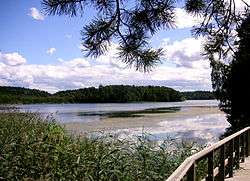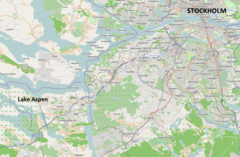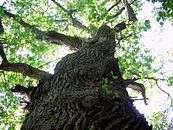Aspen (Botkyrka Municipality)
| Aspen | |
|---|---|
 | |
 Location in relation to Stockholm | |
| Coordinates | 59°13′18″N 17°48′33″E / 59.22167°N 17.80917°ECoordinates: 59°13′18″N 17°48′33″E / 59.22167°N 17.80917°E |
| Catchment area | 7.97 km2 (3.08 sq mi) |
| Basin countries | Sweden |
| Max. length | 3.5 km (2.2 mi) |
| Max. width | 950 m (3,120 ft) |
| Surface area | 1,847 km2 (713 sq mi) |
| Max. depth | 3.5 m (11 ft) |
| Shore length1 | 11.95 km (7.43 mi) |
| Surface elevation | 18 m (59 ft) |
| 1 Shore length is not a well-defined measure. | |
Aspen is a lake of Botkyrka Municipality, Södermanland, Sweden.[1] The lake is crossed by the European route E4/European route E20 and is located about 20 kilometres southwest of Stockholm, the Swedish capital. It has an area of 1,847 km².
During the Stone Age, Aspen was in the ocean, but was uplifted by the time of the Bronze Age. Bronze Age settlements grew up around the lake and for some thousand years Iron Age farms were around the lake. The area developed during this period.[2] A graveyard from that period is preserved in the area.
Skrävsta Ekholmen nature reserve is in the vicinity of the lake with about sixty large oak trees, half of which are centuries old. There are large bats and many other rare animal and plant species. Around the lake is a nature trail at 7½ km length. The path leads through the woods, high above the marsh.
Gallery
-

Lake Aspen, cultural landscape
-

Lake Aspen, nature path
-

Lake Aspen, old oaks
-

Lake Aspen, Lind Hov farm
References
- ↑ Svensk botanisk tidskrift. Svenska botaniska föreningen. 1975. p. 194. Retrieved 2 November 2011.
- ↑ Fischer, Svante (2005). Roman imperialism and Runic literacy: the westernization of Northern Europe (150-800 AD). Department of Archaeology and Ancient History. p. 212. ISBN 978-91-506-1840-2. Retrieved 2 November 2011.